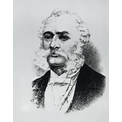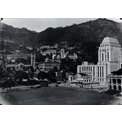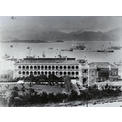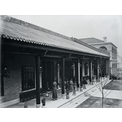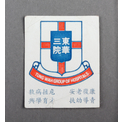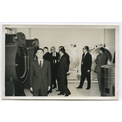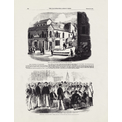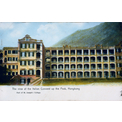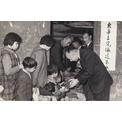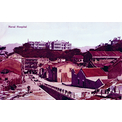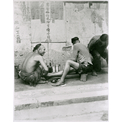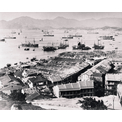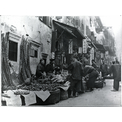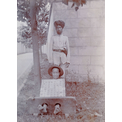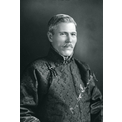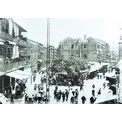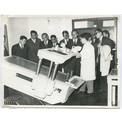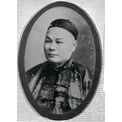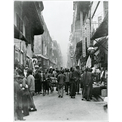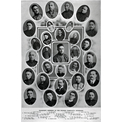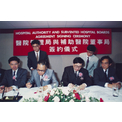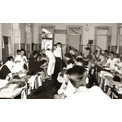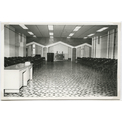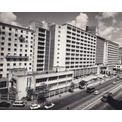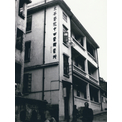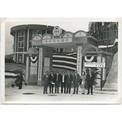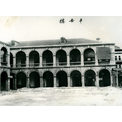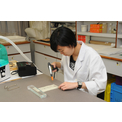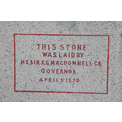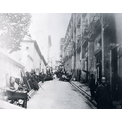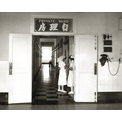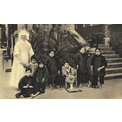 Collections
Collections Hong Kong, Benevolent City: Tung Wah and the Growth of Chinese Communities
Hong Kong, Benevolent City: Tung Wah and the Growth of Chinese Communities All Items
All Items Images
Images
Yat Pit Pavilion in Kennedy Town
The Tung Wah Hospital operated communal graveyards and cemeteries so that unclaimed remains or victims of major disasters could be buried. In the early 20th century, Tung Wah established "farewell pavilions", such as the Yat Pit Pavilion in Kennedy Town, the Wing Pit Pavilion in Pokfulam, the Chien Lee Pavilion in Ho Man Tin and the Sik Pit Pavilion in So Kon Po, to provide a venue for the public to bid a last farewell to their deceased loved ones. This is a photograph of the Yat Pit Pavilion in Kennedy Town.
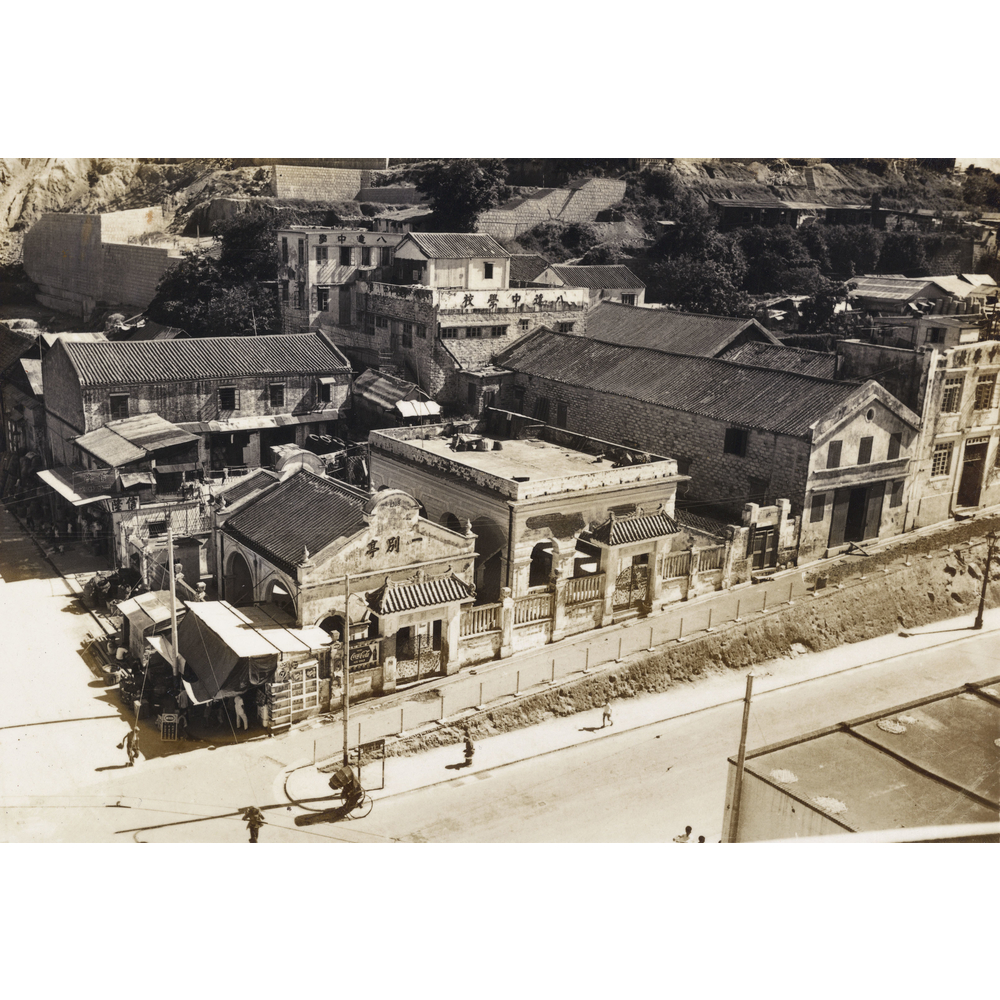
| Date | 1947 to 1958 |
| Place | Hong Kong Island/Central and Western District/Kennedy Town/(Street)/Yat Pit Pavilion |
| object | School | Farewell pavilion | Stall | Rickshaw |
| Material Type | Image |
| Collection | Hong Kong, Benevolent City: Tung Wah and the Growth of Chinese Communities |
| Source | Tung Wah Museum |
| Repository | Tung Wah Museum |
| Note to Copyright | Permission for use in Hong Kong Memory is given by Tung Wah Group of Hospitals |
| Accession No. | lcs-twgh-0114 |
Yat Pit Pavilion in Kennedy Town
The Tung Wah Hospital operated communal graveyards and cemeteries so that unclaimed remains or victims of major disasters could be buried. In the early 20th century, Tung Wah established "farewell pavilions", such as the Yat Pit Pavilion in Kennedy Town, the Wing Pit Pavilion in Pokfulam, the Chien Lee Pavilion in Ho Man Tin and the Sik Pit Pavilion in So Kon Po, to provide a venue for the public to bid a last farewell to their deceased loved ones. This is a photograph of the Yat Pit Pavilion in Kennedy Town.
| Date | 1947 to 1958 |
| Place | Hong Kong Island/Central and Western District/Kennedy Town/(Street)/Yat Pit Pavilion |
| Object | School | Farewell pavilion | Stall | Rickshaw |
| Material Type | Image |
| Collection | Hong Kong, Benevolent City: Tung Wah and the Growth of Chinese Communities |
| Source | Tung Wah Museum |
| Repository | Tung Wah Museum |
| Note to Copyright | Permission for use in Hong Kong Memory is given by Tung Wah Group of Hospitals |
| Accession No. | lcs-twgh-0114 |
Yat Pit Pavilion in Kennedy Town
The Tung Wah Hospital operated communal graveyards and cemeteries so that unclaimed remains or victims of major disasters could be buried. In the early 20th century, Tung Wah established "farewell pavilions", such as the Yat Pit Pavilion in Kennedy Town, the Wing Pit Pavilion in Pokfulam, the Chien Lee Pavilion in Ho Man Tin and the Sik Pit Pavilion in So Kon Po, to provide a venue for the public to bid a last farewell to their deceased loved ones. This is a photograph of the Yat Pit Pavilion in Kennedy Town.
| Date | 1947 to 1958 |
| Place | Hong Kong Island/Central and Western District/Kennedy Town/(Street)/Yat Pit Pavilion |
| Object | School | Farewell pavilion | Stall | Rickshaw |
| Material Type | Image |
| Collection | Hong Kong, Benevolent City: Tung Wah and the Growth of Chinese Communities |
| Source | Tung Wah Museum |
| Repository | Tung Wah Museum |
| Note to Copyright | Permission for use in Hong Kong Memory is given by Tung Wah Group of Hospitals |
| Accession No. | lcs-twgh-0114 |
Yat Pit Pavilion in Kennedy Town
The Tung Wah Hospital operated communal graveyards and cemeteries so that unclaimed remains or victims of major disasters could be buried. In the early 20th century, Tung Wah established "farewell pavilions", such as the Yat Pit Pavilion in Kennedy Town, the Wing Pit Pavilion in Pokfulam, the Chien Lee Pavilion in Ho Man Tin and the Sik Pit Pavilion in So Kon Po, to provide a venue for the public to bid a last farewell to their deceased loved ones. This is a photograph of the Yat Pit Pavilion in Kennedy Town.
| Date | 1947 to 1958 |
| Place | Hong Kong Island/Central and Western District/Kennedy Town/(Street)/Yat Pit Pavilion |
| Object | School | Farewell pavilion | Stall | Rickshaw |
| Material Type | Image |
| Collection | Hong Kong, Benevolent City: Tung Wah and the Growth of Chinese Communities |
| Source | Tung Wah Museum |
| Repository | Tung Wah Museum |
| Note to Copyright | Permission for use in Hong Kong Memory is given by Tung Wah Group of Hospitals |
| Accession No. | lcs-twgh-0114 |
Yat Pit Pavilion in Kennedy Town
The Tung Wah Hospital operated communal graveyards and cemeteries so that unclaimed remains or victims of major disasters could be buried. In the early 20th century, Tung Wah established "farewell pavilions", such as the Yat Pit Pavilion in Kennedy Town, the Wing Pit Pavilion in Pokfulam, the Chien Lee Pavilion in Ho Man Tin and the Sik Pit Pavilion in So Kon Po, to provide a venue for the public to bid a last farewell to their deceased loved ones. This is a photograph of the Yat Pit Pavilion in Kennedy Town.
| Date | 1947 to 1958 |
| Object | School | Farewell pavilion | Stall | Rickshaw |
| Material Type | Image |
| Collection | Hong Kong, Benevolent City: Tung Wah and the Growth of Chinese Communities |
| Source | Tung Wah Museum |
| Repository | Tung Wah Museum |
| Note to Copyright | Permission for use in Hong Kong Memory is given by Tung Wah Group of Hospitals |
| Accession No. | lcs-twgh-0114 |
Yat Pit Pavilion in Kennedy Town
The Tung Wah Hospital operated communal graveyards and cemeteries so that unclaimed remains or victims of major disasters could be buried. In the early 20th century, Tung Wah established "farewell pavilions", such as the Yat Pit Pavilion in Kennedy Town, the Wing Pit Pavilion in Pokfulam, the Chien Lee Pavilion in Ho Man Tin and the Sik Pit Pavilion in So Kon Po, to provide a venue for the public to bid a last farewell to their deceased loved ones. This is a photograph of the Yat Pit Pavilion in Kennedy Town.
| Date | 1947 to 1958 |
| Place | Hong Kong Island/Central and Western District/Kennedy Town/(Street)/Yat Pit Pavilion |
| Object | School | Farewell pavilion | Stall | Rickshaw |
| Material Type | Image |
| Collection | Hong Kong, Benevolent City: Tung Wah and the Growth of Chinese Communities |
| Source | Tung Wah Museum |
| Repository | Tung Wah Museum |
| Note to Copyright | Permission for use in Hong Kong Memory is given by Tung Wah Group of Hospitals |
| Accession No. | lcs-twgh-0114 |
Yat Pit Pavilion in Kennedy Town
The Tung Wah Hospital operated communal graveyards and cemeteries so that unclaimed remains or victims of major disasters could be buried. In the early 20th century, Tung Wah established "farewell pavilions", such as the Yat Pit Pavilion in Kennedy Town, the Wing Pit Pavilion in Pokfulam, the Chien Lee Pavilion in Ho Man Tin and the Sik Pit Pavilion in So Kon Po, to provide a venue for the public to bid a last farewell to their deceased loved ones. This is a photograph of the Yat Pit Pavilion in Kennedy Town.
| Date | 1947 to 1958 |
| Place | Hong Kong Island/Central and Western District/Kennedy Town/(Street)/Yat Pit Pavilion |
| Object | School | Farewell pavilion | Stall | Rickshaw |
| Material Type | Image |
| Collection | Hong Kong, Benevolent City: Tung Wah and the Growth of Chinese Communities |
| Source | Tung Wah Museum |
| Repository | Tung Wah Museum |
| Note to Copyright | Permission for use in Hong Kong Memory is given by Tung Wah Group of Hospitals |
| Accession No. | lcs-twgh-0114 |
Yat Pit Pavilion in Kennedy Town
The Tung Wah Hospital operated communal graveyards and cemeteries so that unclaimed remains or victims of major disasters could be buried. In the early 20th century, Tung Wah established "farewell pavilions", such as the Yat Pit Pavilion in Kennedy Town, the Wing Pit Pavilion in Pokfulam, the Chien Lee Pavilion in Ho Man Tin and the Sik Pit Pavilion in So Kon Po, to provide a venue for the public to bid a last farewell to their deceased loved ones. This is a photograph of the Yat Pit Pavilion in Kennedy Town.
| Date of Death | 1947 to 1958 |
| Place | Hong Kong Island/Central and Western District/Kennedy Town/(Street)/Yat Pit Pavilion |
| Object | School | Farewell pavilion | Stall | Rickshaw |
| Material Type | Image |
| Collection | Hong Kong, Benevolent City: Tung Wah and the Growth of Chinese Communities |
| Source | Tung Wah Museum |
| Repository | Tung Wah Museum |
| Note to Copyright | Permission for use in Hong Kong Memory is given by Tung Wah Group of Hospitals |
| Accession No. | lcs-twgh-0114 |
Yat Pit Pavilion in Kennedy Town
The Tung Wah Hospital operated communal graveyards and cemeteries so that unclaimed remains or victims of major disasters could be buried. In the early 20th century, Tung Wah established "farewell pavilions", such as the Yat Pit Pavilion in Kennedy Town, the Wing Pit Pavilion in Pokfulam, the Chien Lee Pavilion in Ho Man Tin and the Sik Pit Pavilion in So Kon Po, to provide a venue for the public to bid a last farewell to their deceased loved ones. This is a photograph of the Yat Pit Pavilion in Kennedy Town.
| Date | 1947 to 1958 |
| Material Type | Image |
| Collection | Hong Kong, Benevolent City: Tung Wah and the Growth of Chinese Communities |
| Source | Tung Wah Museum |
| Note to Copyright | Permission for use in Hong Kong Memory is given by Tung Wah Group of Hospitals |
| Accession No. | lcs-twgh-0114 |
Yat Pit Pavilion in Kennedy Town
The Tung Wah Hospital operated communal graveyards and cemeteries so that unclaimed remains or victims of major disasters could be buried. In the early 20th century, Tung Wah established "farewell pavilions", such as the Yat Pit Pavilion in Kennedy Town, the Wing Pit Pavilion in Pokfulam, the Chien Lee Pavilion in Ho Man Tin and the Sik Pit Pavilion in So Kon Po, to provide a venue for the public to bid a last farewell to their deceased loved ones. This is a photograph of the Yat Pit Pavilion in Kennedy Town.
| Date | 1947 to 1958 |
| Material Type | Image |
| Place | Hong Kong Island/Central and Western District/Kennedy Town/(Street)/Yat Pit Pavilion |
| Object | School | Farewell pavilion | Stall | Rickshaw |
| Collection | Hong Kong, Benevolent City: Tung Wah and the Growth of Chinese Communities |
| Source | Tung Wah Museum |
| Repository | Tung Wah Museum |
| Note to Copyright | Permission for use in Hong Kong Memory is given by Tung Wah Group of Hospitals |
| Accession No. | lcs-twgh-0114 |
Yat Pit Pavilion in Kennedy Town
The Tung Wah Hospital operated communal graveyards and cemeteries so that unclaimed remains or victims of major disasters could be buried. In the early 20th century, Tung Wah established "farewell pavilions", such as the Yat Pit Pavilion in Kennedy Town, the Wing Pit Pavilion in Pokfulam, the Chien Lee Pavilion in Ho Man Tin and the Sik Pit Pavilion in So Kon Po, to provide a venue for the public to bid a last farewell to their deceased loved ones. This is a photograph of the Yat Pit Pavilion in Kennedy Town.
| Date | 1947 to 1958 |
| Place | Hong Kong Island/Central and Western District/Kennedy Town/(Street)/Yat Pit Pavilion |
| Object | School | Farewell pavilion | Stall | Rickshaw |
| Material Type | Image |
| Collection | Hong Kong, Benevolent City: Tung Wah and the Growth of Chinese Communities |
| Source | Tung Wah Museum |
| Repository | Tung Wah Museum |
| Note to Copyright | Permission for use in Hong Kong Memory is given by Tung Wah Group of Hospitals |
| Accession No. | lcs-twgh-0114 |
Yat Pit Pavilion in Kennedy Town
The Tung Wah Hospital operated communal graveyards and cemeteries so that unclaimed remains or victims of major disasters could be buried. In the early 20th century, Tung Wah established "farewell pavilions", such as the Yat Pit Pavilion in Kennedy Town, the Wing Pit Pavilion in Pokfulam, the Chien Lee Pavilion in Ho Man Tin and the Sik Pit Pavilion in So Kon Po, to provide a venue for the public to bid a last farewell to their deceased loved ones. This is a photograph of the Yat Pit Pavilion in Kennedy Town.
| Date | 1947 to 1958 |
| Place | Hong Kong Island/Central and Western District/Kennedy Town/(Street)/Yat Pit Pavilion |
| Object | School | Farewell pavilion | Stall | Rickshaw |
| Material Type | Image |
| Collection | Hong Kong, Benevolent City: Tung Wah and the Growth of Chinese Communities |
| Source | Tung Wah Museum |
| Repository | Tung Wah Museum |
| Note to Copyright | Permission for use in Hong Kong Memory is given by Tung Wah Group of Hospitals |
| Accession No. | lcs-twgh-0114 |
Yat Pit Pavilion in Kennedy Town
The Tung Wah Hospital operated communal graveyards and cemeteries so that unclaimed remains or victims of major disasters could be buried. In the early 20th century, Tung Wah established "farewell pavilions", such as the Yat Pit Pavilion in Kennedy Town, the Wing Pit Pavilion in Pokfulam, the Chien Lee Pavilion in Ho Man Tin and the Sik Pit Pavilion in So Kon Po, to provide a venue for the public to bid a last farewell to their deceased loved ones. This is a photograph of the Yat Pit Pavilion in Kennedy Town.
| Date | 1947 to 1958 |
| Place | Hong Kong Island/Central and Western District/Kennedy Town/(Street)/Yat Pit Pavilion |
| Object | School | Farewell pavilion | Stall | Rickshaw |
| Material Type | Image |
| Collection | Hong Kong, Benevolent City: Tung Wah and the Growth of Chinese Communities |
| Source | Tung Wah Museum |
| Repository | Tung Wah Museum |
| Note to Copyright | Permission for use in Hong Kong Memory is given by Tung Wah Group of Hospitals |
| Accession No. | lcs-twgh-0114 |
Yat Pit Pavilion in Kennedy Town
The Tung Wah Hospital operated communal graveyards and cemeteries so that unclaimed remains or victims of major disasters could be buried. In the early 20th century, Tung Wah established "farewell pavilions", such as the Yat Pit Pavilion in Kennedy Town, the Wing Pit Pavilion in Pokfulam, the Chien Lee Pavilion in Ho Man Tin and the Sik Pit Pavilion in So Kon Po, to provide a venue for the public to bid a last farewell to their deceased loved ones. This is a photograph of the Yat Pit Pavilion in Kennedy Town.
| Date | 1947 to 1958 |
| Place | Hong Kong Island/Central and Western District/Kennedy Town/(Street)/Yat Pit Pavilion |
| Object | School | Farewell pavilion | Stall | Rickshaw |
| Material Type | Image |
| Collection | Hong Kong, Benevolent City: Tung Wah and the Growth of Chinese Communities |
| Source | Tung Wah Museum |
| Repository | Tung Wah Museum |
| Note to Copyright | Permission for use in Hong Kong Memory is given by Tung Wah Group of Hospitals |
| Accession No. | lcs-twgh-0114 |
Yat Pit Pavilion in Kennedy Town
The Tung Wah Hospital operated communal graveyards and cemeteries so that unclaimed remains or victims of major disasters could be buried. In the early 20th century, Tung Wah established "farewell pavilions", such as the Yat Pit Pavilion in Kennedy Town, the Wing Pit Pavilion in Pokfulam, the Chien Lee Pavilion in Ho Man Tin and the Sik Pit Pavilion in So Kon Po, to provide a venue for the public to bid a last farewell to their deceased loved ones. This is a photograph of the Yat Pit Pavilion in Kennedy Town.
| Date | 1947 to 1958 |
| Place | Hong Kong Island/Central and Western District/Kennedy Town/(Street)/Yat Pit Pavilion |
| Object | School | Farewell pavilion | Stall | Rickshaw |
| Material Type | Image |
| Collection | Hong Kong, Benevolent City: Tung Wah and the Growth of Chinese Communities |
| Source | Tung Wah Museum |
| Repository | Tung Wah Museum |
| Note to Copyright | Permission for use in Hong Kong Memory is given by Tung Wah Group of Hospitals |
| Accession No. | lcs-twgh-0114 |
Yat Pit Pavilion in Kennedy Town
The Tung Wah Hospital operated communal graveyards and cemeteries so that unclaimed remains or victims of major disasters could be buried. In the early 20th century, Tung Wah established "farewell pavilions", such as the Yat Pit Pavilion in Kennedy Town, the Wing Pit Pavilion in Pokfulam, the Chien Lee Pavilion in Ho Man Tin and the Sik Pit Pavilion in So Kon Po, to provide a venue for the public to bid a last farewell to their deceased loved ones. This is a photograph of the Yat Pit Pavilion in Kennedy Town.
| Date | 1947 to 1958 |
| Place | Hong Kong Island/Central and Western District/Kennedy Town/(Street)/Yat Pit Pavilion |
| Object | School | Farewell pavilion | Stall | Rickshaw |
| Material Type | Image |
| Collection | Hong Kong, Benevolent City: Tung Wah and the Growth of Chinese Communities |
| Source | Tung Wah Museum |
| Repository | Tung Wah Museum |
| Note to Copyright | Permission for use in Hong Kong Memory is given by Tung Wah Group of Hospitals |
| Accession No. | lcs-twgh-0114 |
Yat Pit Pavilion in Kennedy Town
The Tung Wah Hospital operated communal graveyards and cemeteries so that unclaimed remains or victims of major disasters could be buried. In the early 20th century, Tung Wah established "farewell pavilions", such as the Yat Pit Pavilion in Kennedy Town, the Wing Pit Pavilion in Pokfulam, the Chien Lee Pavilion in Ho Man Tin and the Sik Pit Pavilion in So Kon Po, to provide a venue for the public to bid a last farewell to their deceased loved ones. This is a photograph of the Yat Pit Pavilion in Kennedy Town.
| Date | 1947 to 1958 |
| Place | Hong Kong Island/Central and Western District/Kennedy Town/(Street)/Yat Pit Pavilion |
| Object | School | Farewell pavilion | Stall | Rickshaw |
| Material Type | Image |
| Collection | Hong Kong, Benevolent City: Tung Wah and the Growth of Chinese Communities |
| Source | Tung Wah Museum |
| Repository | Tung Wah Museum |
| Note to Copyright | Permission for use in Hong Kong Memory is given by Tung Wah Group of Hospitals |
| Accession No. | lcs-twgh-0114 |
Yat Pit Pavilion in Kennedy Town
The Tung Wah Hospital operated communal graveyards and cemeteries so that unclaimed remains or victims of major disasters could be buried. In the early 20th century, Tung Wah established "farewell pavilions", such as the Yat Pit Pavilion in Kennedy Town, the Wing Pit Pavilion in Pokfulam, the Chien Lee Pavilion in Ho Man Tin and the Sik Pit Pavilion in So Kon Po, to provide a venue for the public to bid a last farewell to their deceased loved ones. This is a photograph of the Yat Pit Pavilion in Kennedy Town.
| Date | 1947 to 1958 |
| Place | Hong Kong Island/Central and Western District/Kennedy Town/(Street)/Yat Pit Pavilion |
| Object | School | Farewell pavilion | Stall | Rickshaw |
| Material Type | Image |
| Collection | Hong Kong, Benevolent City: Tung Wah and the Growth of Chinese Communities |
| Source | Tung Wah Museum |
| Repository | Tung Wah Museum |
| Note to Copyright | Permission for use in Hong Kong Memory is given by Tung Wah Group of Hospitals |
| Accession No. | lcs-twgh-0114 |
Copyright © 2012 Hong Kong Memory

